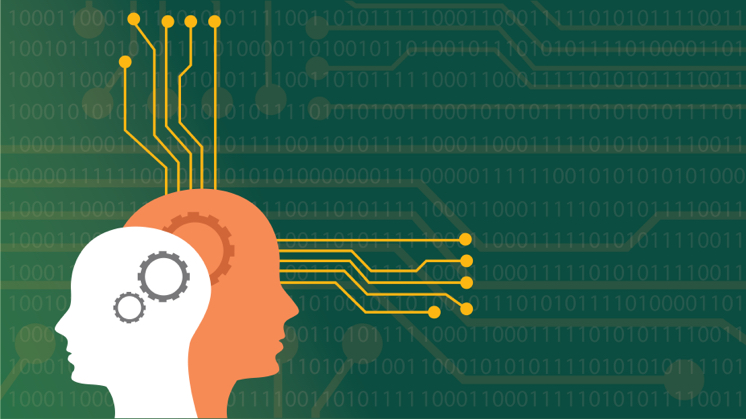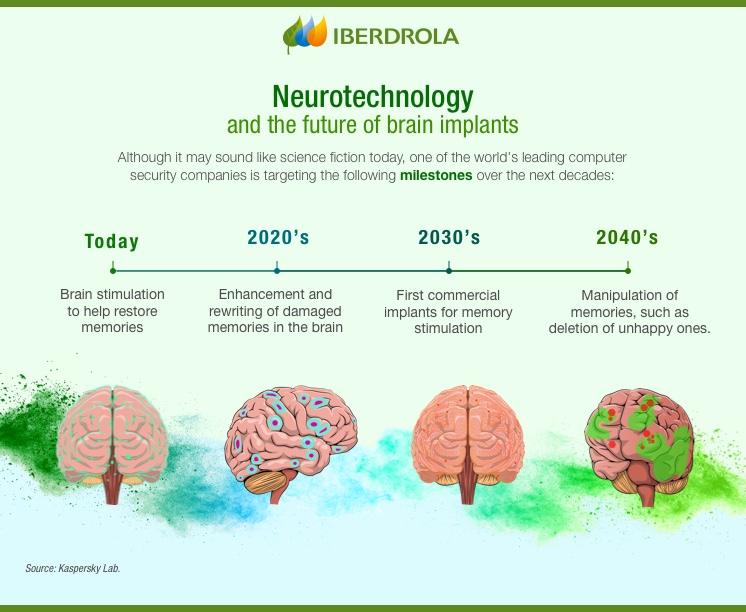Neurotechnology
Neurotechnology, how to reveal the secrets of the human brain?
Neurotechnology, which, hand in hand with neuroscience, seeks to unravel the enigmas of the brain, is not a new discipline, but with the meteoric development of artificial intelligence it opens up a world of almost infinite possibilities. On the one hand, there are questions about the applications, which may even include curing brain injuries, and, on the other, about the limits derived from the union between brain and machine, to the point that concepts such as neuro-rights are beginning to become popular.

You wake up in the morning and think about having some chocolate scones for breakfast. As soon as you visualise the sweets in your head, your mobile phone sends you a notification: "Craving detected, wouldn't you rather eat something healthier? It sounds like science fiction, but it is just one of the countless applications that neurotechnology will bring us in the coming decades.
WHAT IS NEUROTECHNOLOGY
Neurotechnology encompasses all technologies developed to understand the brain, visualise its processes and even control, repair or improve its functions. Although electroencephalography is almost a century old, the first major breakthrough in this field has come in recent decades with brain imaging using magnetic resonance imaging (MRI) scans. This technique, among other things, has allowed researchers to identify which areas of the brain are activated or deactivated during certain tasks.
From there, neurotechnology has reached other areas that normally go unnoticed, ranging from the development of drugs to treat mental disorders such as depression, insomnia or attention deficit disorder, to technologies dedicated to neurological rehabilitation after cerebrovascular accidents or to hearing recovery with cochlear implants. And this, as we shall see below, has only just begun.
NEUROTECHNOLOGY PRACTICES AND TECHNIQUES
Neurotechnology uses different techniques to record brain activity and stimulate parts of the brain at will. Non-invasive techniques are those that allow action from the outside, while invasive techniques require the implantation of electrodes through surgery.
Among those dedicated to recording brain activity are:
- Electroencephalogram (EEG) is the oldest non-invasive technique and records the electrical activity of the brain using electrodes placed on the scalp.
- Functional magnetic resonance imaging (fMRI) measures brain activity by detecting changes in brain blood flow using high resolution. It is a more costly process.
- Functional near-infrared spectroscopy (fNIRS) uses hand-held sensors placed on the scalp and it has a lower resolution than fMRI.
- Implantation of microneedles is an invasive technique that involves inserting tiny electrodes into the cerebral cortex. The signals are very clear, but reach a very limited area.
In terms of techniques to stimulate the brain, these are the most commonly used:
- Transcranial electrical stimulation (tES) is a non-invasive technique in which small currents are applied to electrodes located on the scalp. It can stimulate certain functions.
- Transcranial magnetic stimulation (TMS) follows the same principle, but uses magnetic pulses through coils placed on the scalp. The magnetic field produces electrical current flows in the brain, altering communication between neurons, and has been used to improve perception, learning and memory.
- Focused ultrasound (FUS) is a non-invasive technology that applies focused pulses of infrared light to stimulate specific areas of the brain. It can be applied, for example, through the eyes or nose.
- Deep brain stimulation (DBS) is performed by surgically implanting electrodes that act as neurostimulators. They have been used successfully in humans to alleviate the symptoms of diseases such as Parkinson's disease or epilepsy.
Cognitive technologies
Neurotechnology is related to cognitive technologies. According to consulting firm Deloitte, these are technologies derived from artificial intelligence that allow tasks to be performed that previously could only be done by humans. Some examples are artificial vision, machine learning, deep learning, natural language processing or robotic process automation, among others.
In particular, the data obtained on the functioning of the brain is used to develop artificial neural networks. For example, the aforementioned machine vision can be used to identify a person's emotions by analysing their facial expressions. In addition, the use of these technologies will also enable further development of neurodidactics, thus improving learning methods and processes.
APPLICATIONS OF NEUROTECHNOLOGY
Below, we review some of the most recent applications:
 Neuronal biofeedback
Neuronal biofeedback
Using real-time EEG or fMRI, someone can be taught to control their central nervous functions, such as heartbeat.
 Next generation neuropharmacology
Next generation neuropharmacology
Behavioural and molecular neuropharmacology are benefiting from a better understanding of the nervous system to develop more effective drugs.
 Neuroprostheses
Neuroprostheses
These devices are able to replace motor, sensory or cognitive abilities damaged as a result of injury or disease.
 Neural interfaces
Neural interfaces
Brain-computer interfaces are fundamental in the development of new sensors and prostheses, allowing signals to be sent and received in real time.
 Optogenetic implants
Optogenetic implants
The combination of neurotechnology, genetics and optogenetics allows specific genes in neural tissue to be switched on or off using focused light.

Neurotechnology is advancing by leaps and bounds, which is why it sometimes seems to us to be entering the realms of science fiction. One example is augmented capabilities, i.e. the possibility of amplifying the senses and mental capacities — almost like a superhero —. Another has to do with the development of brain-brain interfaces, which would be able to translate thoughts, sensations or impulses into digital signals that could be transmitted to another person — is telepathy closer? —.
THE LATEST ADVANCES IN NEUROTECHNOLOGY
Major neurotechnology projects are currently in the hands of large technology companies. In 2016, billionaire Elon Musk, creator of Tesla and SpaceX, launched Neuralink, a company dedicated to the development of an implantable brain-machine interface. The idea is, through painless surgery, to implant very thin wires — about five microns in diameter — into the cerebral cortex to obtain and send information.
Founded in the same year, the company Kernel has a prototype of a non-invasive brain interface based on near-infrared spectroscopy. In particular, it is a helmet, which for the time being is a gadget, capable of identifying, for example, moods. Giants such as Facebook and Google are also developing their own neurotechnology projects.
The limits of neurotechnology: neurorights
The capabilities of neurotechnology focus on detecting what is happening inside the brain so that, when the time comes, it can influence its functions. This is where the ethical limits appear because this, taken to the extreme and as a result of technological evolution, can be tantamount to reading, even controlling, a person's thoughts and emotions.
According to the prestigious journal Scientific American External link, opens in new window., advances in neurotechnology require a parallel evolution of neurorights. In the near future, private companies could have access to the vast amounts of data that neurotechnological devices will yield, and these rights would focus on the protection of such personal information and the prevention of risks arising from it, such as epigenetic modifications, neuropsychiatric complications or its use for biohacking.
External link, opens in new window., advances in neurotechnology require a parallel evolution of neurorights. In the near future, private companies could have access to the vast amounts of data that neurotechnological devices will yield, and these rights would focus on the protection of such personal information and the prevention of risks arising from it, such as epigenetic modifications, neuropsychiatric complications or its use for biohacking.




